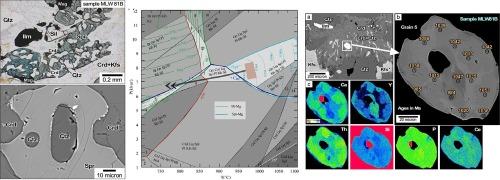Sapphirine + quartz assemblage from the Irumide Belt, northern Malawi: Implications for Mesoproterozoic ultrahigh-temperature metamorphism related to Rodinia assembly
IF 3.2
2区 地球科学
Q2 GEOSCIENCES, MULTIDISCIPLINARY
引用次数: 0
Abstract
The Irumide Belt sensu lato situated between the Bangweulu Block to the northwest and the Neoproterozoic Mozambique–Zambezi Belt to the southeast is a Mesoproterozoic orogenic belt that developed probably during the amalgamation of the supercontinent Rodinia. In this study, we present new petrological, geothermobarometric, and geochronological data of pelitic granulites and related rocks from the Jenda area in northern Malawi, and evaluate the timing and pressure–temperature (P–T) conditions of high-grade metamorphism. To the best of our knowledge, we are the first to report the occurrence of sapphirine + quartz association in pelitic granulite from the Irumide Belt sl. which provides a robust evidence of peak ultrahigh-temperature (UHT) metamorphism. The sapphirine occurs as poikiloblastic grains with rounded quartz inclusions in the absence of any retrograde minerals. The mineral phase equilibrium modeling constrains the peak UHT conditions of the pelitic granulites as 950–1000 °C and 7–8.5 kbar for sapphirine-bearing and ∼6 kbar and > 950 °C for sapphirine-free samples. These conditions are consistent with the results of ternary-feldspar geothermometry (900–1000 °C at 8 kbar). From the stability of rutile, we estimate a prograde pressure of >9 kbar, and the occurrence of retrograde cordierite and biotite suggests that the rocks went through P–T conditions of ∼6–7 kbar/∼775–825 °C, indicating a clockwise P–T path and defining high-pressure and UHT conditions. In-situ monazite Th–U–Pbtotal geochronology of the sapphirine-bearing rock yielded a weighted-mean age of 1022 ± 10 Ma which is considered to mark the timing of peak metamorphism. Sapphirine-free granulites also gave consistent ages of 1049 ± 13 Ma and 1048 ± 10 Ma, which are also comparable with published ages. We thus infer that the Irumide Belt sl. underwent regional high-pressure to UHT metamorphism at ca. 1.05 to 1.02 Ga possibly related to the main collisional event of the Bangweulu Block with an unknown craton or magmatic arc during the assembly of Rodinia supercontinent.

马拉维北部伊鲁米德带的蓝宝石+石英组合:与罗迪尼亚组装有关的中新生代超高温变质作用的含义
伊鲁米德带(Irumide Belt sensu lato)位于西北部的邦圭鲁地块(Bangweulu Block)和东南部的新新生代莫桑比克-赞比西河带(Mozambique-Zambezi Belt)之间,是一条中新生代造山带,可能是在罗迪尼亚超大陆(Rodinia)的合并过程中形成的。在本研究中,我们展示了马拉维北部詹达地区的辉长岩花岗岩及相关岩石的岩石学、地球温度-压力-温度(P-T)新数据,并对高品位变质作用的时间和压力-温度(P-T)条件进行了评估。据我们所知,我们首次报告了伊鲁米德带斜坡的球粒花岗岩中出现的蓝绿辉石+石英关联,这为峰值超高温变质作用提供了有力的证据。在没有任何逆生矿物的情况下,蓝绿辉石以带有圆形石英包裹体的黝帘晶形式出现。根据矿物相平衡模型,含蓝绿辉石的球粒花岗岩的超高温峰值条件为 950-1000 ℃ 和 7-8.5 千巴,不含蓝绿辉石的样品的超高温峰值条件为 ∼6 千巴和 > 950 ℃。这些条件与三元长石测地热的结果(8 千巴下 900-1000 ℃)一致。根据金红石的稳定性,我们估计顺行压力为>9千巴,逆行堇青石和黑云母的出现表明岩石经历了∼6-7千巴/∼775-825 °C的P-T条件,这表明了顺时针的P-T路径,并确定了高压和超高温条件。对含蓝宝石的岩石进行的原位独居石Th-U-Pbtotal地质年代测定得出的加权平均年龄为1022 ± 10 Ma,这被认为是变质高峰期的标志。不含蓝绿辉石的花岗岩也给出了一致的年龄,分别为 1049 ± 13 Ma 和 1048 ± 10 Ma,与已公布的年龄相当。因此,我们推断伊鲁米德带斜坡在大约 1.05 至 1.02 Ga 时经历了区域高压至超高温变质作用。我们由此推断,伊鲁米德带斜坡在大约 1.05 至 1.02 Ga 时经历了区域高压至超高温变质作用,这可能与罗迪尼亚超大陆组装过程中邦圭鲁块与未知克拉通或岩浆弧的主要碰撞事件有关。
本文章由计算机程序翻译,如有差异,请以英文原文为准。
求助全文
约1分钟内获得全文
求助全文
来源期刊

Precambrian Research
地学-地球科学综合
CiteScore
7.20
自引率
28.90%
发文量
325
审稿时长
12 months
期刊介绍:
Precambrian Research publishes studies on all aspects of the early stages of the composition, structure and evolution of the Earth and its planetary neighbours. With a focus on process-oriented and comparative studies, it covers, but is not restricted to, subjects such as:
(1) Chemical, biological, biochemical and cosmochemical evolution; the origin of life; the evolution of the oceans and atmosphere; the early fossil record; palaeobiology;
(2) Geochronology and isotope and elemental geochemistry;
(3) Precambrian mineral deposits;
(4) Geophysical aspects of the early Earth and Precambrian terrains;
(5) Nature, formation and evolution of the Precambrian lithosphere and mantle including magmatic, depositional, metamorphic and tectonic processes.
In addition, the editors particularly welcome integrated process-oriented studies that involve a combination of the above fields and comparative studies that demonstrate the effect of Precambrian evolution on Phanerozoic earth system processes.
Regional and localised studies of Precambrian phenomena are considered appropriate only when the detail and quality allow illustration of a wider process, or when significant gaps in basic knowledge of a particular area can be filled.
 求助内容:
求助内容: 应助结果提醒方式:
应助结果提醒方式:


